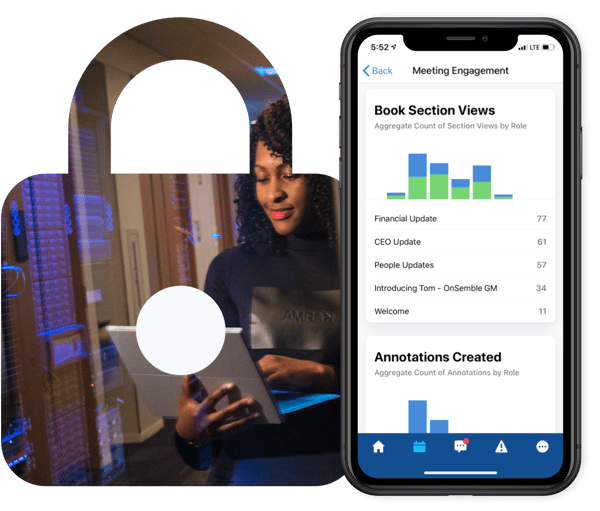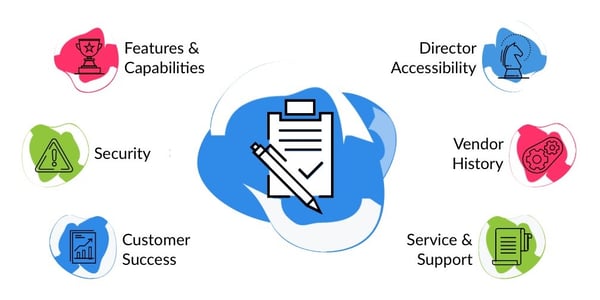
A board portal is a secure and reliable hub used by CEOs, board directors, and administrators to help manage board meetings.
That is why it is frequently called board management software. It is a complete suite of tools that allows members to go over meeting materials, communicate with one another, and see to other tasks and responsibilities.
This eliminates the need to print countless reams of paper and exchange a flurry of emails to get organized both before and after a board meeting. With a board portal, boards are able to meet remotely and keep all necessary information and files secure and in one place.
Because there are so many tools involved, it is easier to separate board portal users into two groups. One set of tools is for the administrative staff who work to prepare the meeting to run smoothly. The other set is for the board members and enables them to take action and make decisions within the portal.
Here is a brief rundown of what board portals look like throughout the entire meeting process.
Ultimately, board management software offers a comprehensive solution to several distinct challenges faced by many boards today.
Recently, organizations have ramped up their investment in video conferencing technology to meet together remotely. Yet, as we've moved to virtual meetings, a new host of problems has arisen. So-called Zoom fatigue and a lack of natural body language cues has made it a challenge to stay fully engaged. Worst of all, we’re compensating by piecing together dozens of apps to help us – too many solutions that cause our information to be scattered across our computers.
Because board portals were built with virtual meetings in mind, they arrive purpose-built for this moment where meeting virtually has become common. They often contain the tools and technology to bridge divides, keep teams organized, and help leaders make better decisions.
We’ve heard from existing and potential customers alike that virtual meetings have presented new challenges for them as their teams went remote. Luckily, with decades spent thinking about remote meetings, there is advice and counsel on how to overcome these challenges.

Virtual meetings just make it tougher to have a conversation. The moment two people speak at the same time, it becomes inaudible. And moments of silence followed by “sorry I was on mute,” detract from the rhythm of any conversation. This leads to ideas and contributions that would occur in-person going unsaid.
Board portals help increase the frequency of quality communication. They enable leaders to discuss and deliberate throughout the platform before ever jumping into a meeting. Through secure chat, sharable annotations, and news and announcement panels, board portals deliver information and lets you skip a call. And when you have to jump into a meeting, its video conferencing integrations enable conversations directly in the platform.

Without being together, it's hard to get a sense of the room – what people are thinking. Body language is 65% of communication, and being virtual means is harder than ever to stay on track and engaged in conversation.
Board Portals enable teams to make decisions, gather feedback, and execute responsibilities outside meetings. Many come with built-in e-signature capabilities to execute contracts on-the-go. They enable votes to be taken from anywhere – meaning decisions can be reached throughout the week. And their survey capabilities allow teams to reach consensus before they ever arrive to talk about the more important things.
It’s not like there’s fewer things to decide or less to talk about when you’re meeting virtually. But video conferencing is going to limit how much is said, and there’s only so long people can maintain focus. One interruption or useless aside can derail discussions, drop engagement, and make reaching consensus harder than ever.
Board portals help teams know precisely what needs to be discussed, what decisions need to be reached, and maintain engagement throughout the meeting. It equips leaders to do the leg work of thinking through these critical issues before the meeting starts. And it creates a system of accountability for follow ups after you adjourn.
Being virtual has made retrieving essential reports and documents a total nightmare. It often means going through the trials and tribulations of accessing a server through a VPN. Once connected, it might not be stable or have an internet connection. So we quickly save documents to local storage, signoff, and 15 minutes later realize we need to reconnect again.
Board portals are a secure environment often with unlimited storage for every document, report, and file. Best of all, that security means you don’t need to access a VPN to retrieve the information. Board of directors trust board portals for their companies most sensitive documents, meaning they’re a no brainer for all your storage needs.

Being away from the office often means needing a VPN to access your most important data. That’s because you’re not protected by the sophisticated systems and security achieved throughout the years. Left to your home internet, it's important to stay vigilant about how and what kinds of data you access.
Board Portals are secure environments that keep everything safe. They often have two-factor authentication enabled and are secured by leading technologies giants. Many leverage face ID and touch ID technology to make everything even safer.

Once you decide a board portal is the right solution for you, you will find yourself overwhelmed by the list of board portal providers. However, there are some easy ways to screen them for validity and capability. Here are a few ideas for what to ask when choosing a board portal provider.
When you land on a vendor you’d like to consider, be up front and ask for a free trial. There is no better way to know if something works for you than to try it firsthand. This is not an uncommon practice for vendors, and in fact, it is likely they have one because they take pride in their product and know its performance will meet your expectations.
There is no reason to get caught in the tangles of a contract before you know how the product works. As with all relationships, you have to get to know one another before making a commitment.
Once you’re able to access the app in trial mode, it will become obvious whether it suits the needs of your board. Be sure to have them try it out and provide you feedback as you search for vendors. The board members are the ones actually using the software, so if they approve, then you know you’ve found a quality vendor.
In this digital age, some of the best insights into software await you online. You can read a variety of reviews from individuals who have experienced the software firsthand.
After the reviews are in, look for trends among the reviews. Assess who has won honors and awards for their product and services. These are not self-appointed titles. These are genuine accolades promoted by real-life customers who loved the product so much, they felt compelled to leave a review.
It may shock you to learn that there are still many providers who have not adapted their technology for mobile devices. They may also have slowed down their investment in the product itself by leaving it as is rather than adjusting it for perfection.
A quick way to find these holes is to ask directly and pointedly if the software is available for use on all iOS and Android devices and to ask for the release notes about recent updates, anywhere from three to five. If the software lacks compatibility, you’ll know far in advance. If the recent updates happened more than six months ago, then you can tell they’ve stopped trying to increase their product’s capabilities.
You will need to have an in-depth understanding of a software’s underlying technology. It is what makes that particular software stand out among the rest. For example, older software relies on legacy technology while the latest technology uses the cloud. This is a quick and effective way to screen for those companies who reached their peak at the beginning of the digital boom but who missed the opportunities and updates for current devices and trends. These are often the same companies who will deny you a free trial. Their technology quite literally doesn’t support it.
The benefits to the cloud are all-encompassing. Not only is it more cost-effective for the vendor but those savings trickle down to you with no loss of quality. Cloud technology is designed for all types of devices and browsers and has superior redundancy, availability, and security.
You know how board portals work, you know how to screen the vendors, but now it’s time to look to partnerships. Which vendor will truly connect with your company and drive its success while staying connected to your core mission and values? Make sure the vendor you choose puts these rules front and center:
Assess whether the software vendor puts the customer at the center of its efforts. If a company is investing time in customer care, then they are not just looking to sell you a software and be done. They are looking to create something for you that has true utility and will help you solve your problems. In the end, if you win, they win. Their product is an ever-evolving entity designed with you in mind. That is a business who wants to share a partnership.
One way to evaluate a company’s dedication to customer success is to ask if you’ll have your own customer success manager. The answer should be yes. Then you need to dig deeper and find how that relationship will be managed, what sort of accessibility can they provide when problems arise, and how they can improve your overall experience with the software. An objective way to evaluate the customer success team is to ask for their NPS score and industry specialization.
Before settling on a software, there is another important checkpoint: do they share in your core values as a company? If they don’t, you could become just another invoice to them, or you could find your priorities diverging at a critical point. Here are some what ifs to ponder.
It is often the case that a board is made up of members spread across the globe. They are dynamic decision-making bodies, but it is difficult to get all of them centralized frequently enough for their leadership to be effective. The board and their reporting committees are in need of a virtual solution for this globalized world.
A board portal provides the answer because it is a hub for all important documents, notes, conversations, and decision-making tools necessary for a board to be efficient and impactful. Now that you have the answer, take action. Find some vendors, evaluate them in-depth, and find the partnership that’s right for you. However, time is valuable, and lost time is a waste. Make a board portal a priority so you can be on the forefront of the virtual world and avoid falling behind.
Paroon Chadha co-founded Passageways in 2003 and continues to lead as CEO. He is an angel investor and serves on boards at Big Brother Big Sister of Greater Lafayette, Simon Cancer Center, and TechPoint.
As a B2B SaaS buyer, or even just an everyday software user, you've experienced the following...
 by Benjamin Brandall
by Benjamin Brandall
In a sea of stakeholders, pick the customer.
.jpg) by Aayushi Sanghavi
by Aayushi Sanghavi
We recently had the opportunity to host representatives from G2’s Executive Advisory Board...
 by Godard Abel
by Godard Abel
As a B2B SaaS buyer, or even just an everyday software user, you've experienced the following...
 by Benjamin Brandall
by Benjamin Brandall
In a sea of stakeholders, pick the customer.
.jpg) by Aayushi Sanghavi
by Aayushi Sanghavi


